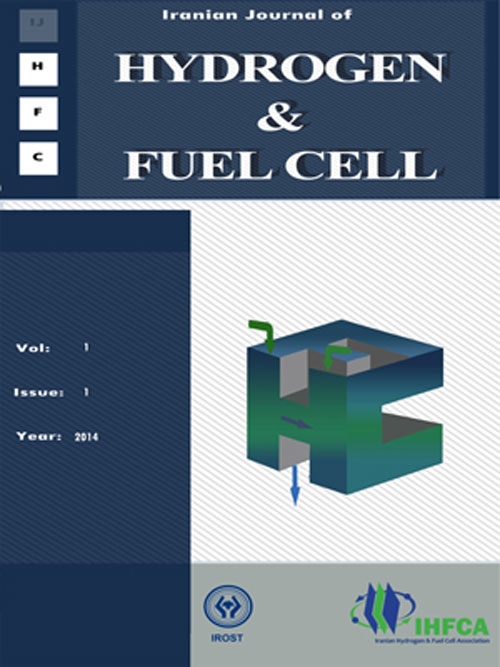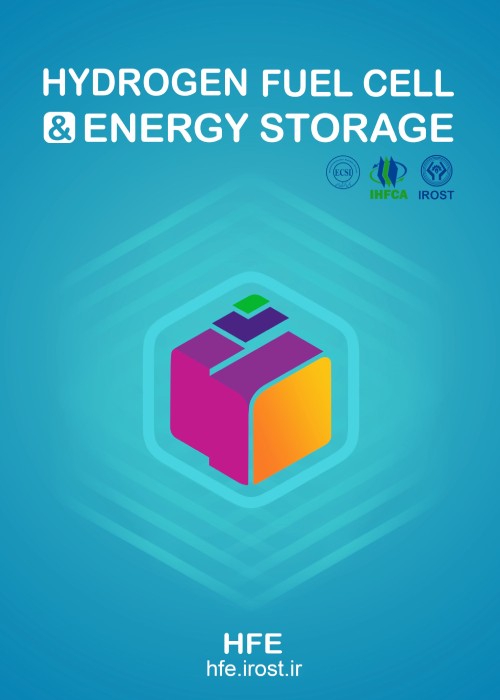فهرست مطالب

Journal of Hydrogen, Fuel Cell and Energy Storage
Volume:8 Issue: 2, Spring 2021
- تاریخ انتشار: 1400/03/11
- تعداد عناوین: 6
-
-
Pages 61-68The design and production of new materials to safely store hydrogen are challenging in hydrogen storage technology. Porous carbon materials such as carbon nanotubes (CNTs) are novel candidates for this aim. Predicting the hydrogen adsorption isotherm on these new materials can be done very effectively. Artificial neural network modeling (ANN) is a helpful tool for this aim. In this study, a feed-forward ANN with one hidden layer was constructed and tested to model the equilibrium data of hydrogen adsorption onto Ni-decorated CNTs. CNT properties like surface area, pore volume, and experimental conditions are used as inputs to predict the corresponding hydrogen uptake in equilibrium conditions. The constructed ANN was found to be precise in modeling the hydrogen adsorption isotherms for all inputs during the training process. The trained network successfully simulates the hydrogen adsorption isotherm for new inputs, which are kept unaware of the ANN during the training process. This shows the power of the created ANN model to determine adsorption isotherms for any operating conditions under the studied constraints.Keywords: Hydrogen adsorption, Carbon Nanotube, Isotherm, Artificial neural network
-
Pages 69-76
In the present work, a Ruddlesden-Popper oxide, La1.9Sr0.1Ni0.7Cu0.3O4 (LSNC), has been synthesized by solid state reaction for Intermediate-Temperature Solid Oxide Fuel Cells (IT-SOFCs) applications. To investigate the effect of sintering temperature on the microstructure and electrical properties, the LSNC cathode samples were fired in the temperature range of 1000–1300 °C. The crystal structure and microstructures of the synthesized and fired samples were studied by XRD and SEM, respectively. The electrical conductivity of the monolithic electrodes is investigated experimentally through the four-probe method as a function of temperature in the range of 300 – 800 oC. Our investigation revealed that the LSNC material behaves like semiconductor materials; the conductivity increases by increasing the temperature up to a specific temperature but then decreases with further temperature increases. It has also been proven that an increase in sintering temperature leads to increasing electrical conductivity. The maximum total electrical conductivity of 67.57 S cm−1 at 450 °C was recorded for pure LSNC material sintered at 1300 °C.
Keywords: Electrical conductivity, Cathode, Solid Oxide Fuel Cells -
Pages 77-93
The All-Porous Solid Oxide Fuel Cell is a concept in which the electrolyte layer, similar to the other two layers, is porous. Thus, firm sealing between cell layers is not a concern, and fuel and oxidant are free to intermix through the porous electrolyte. Furthermore, The All-Porous Solid Oxide Fuel Cell does not need any sealant, and crack generation in its electrolyte component does not terminate cell operation. Cell performance enhancement, based on the flow geometry, is the main target of this study. To achieve this goal, two flow configurations, co-flow and counter-flow, are considered and compared for a hydrogen-fuelled planar All-Porous Solid Oxide Fuel Cell. A finite element method-based commercial software is utilized to solve the nonlinear governing equations of mass, momentum, energy, charge balance, and gas-phase species coupled with kinetics equations. The results include velocity field distribution, species mole fraction in different layers, and temperature contours within the cell. Results show that the counter flow configuration concept reveals better cell performance.
Keywords: Hydrogen, Solid oxide fuel cell, All-porous, Flow geometry -
Pages 95-101A high porous three-dimensional structure of ternary NiPC alloy (3D-NiPC) was prepared with a simple, cheap, and efficient method called dynamic hydrogen bubble template (DHBT) and characterized by means of microstructural and electrochemical techniques with regard to its catalytic effect toward the hydrogen evolution reaction (HER) in an alkaline solution. The electrochemical efficiency of the alloy has been evaluated on the basis of electrochemical data obtained from the steady-state polarization Tafel curves and electrochemical impedance spectroscopy (EIS) in a 1 M NaOH solution at 298 K. The results showed that the three-dimensional structure of NiPC alloy effectively increased its catalytic activity toward the HER. The 3D-NiPC alloy is characterized by low overpotential at practical high current densities, large real surface area, and double-layer capacitance. Also, the 3D-NiPC showed very good physical and electrochemical stability. A high roughness factor (three orders of magnitude; Rf=3550), low overpotential at 250 mAcm-2 (η250=173.3 mV), and low charge transfer resistance (Rct=100 Ωcm2) were obtained in the best conditions, in 1 M NaOH at 298 K.Keywords: Hydrogen evolution reaction (HER), three-dimensional NiPC alloy, electrocatalytic activity, Electrodeposition
-
Pages 103-112One of the most important methods for efficient hydrogen utilization is the proton exchange membrane fuel cell (PEMFC) because of its low environmental impact and easy maintenance. Depletion of fossil fuels along with global warming is all the more reason for researchers to seek new methods to convert primary energy into power, heating, etc. In the meantime, fuel cells are a promising method to convert energy into usable power. In this study, a proton exchange membrane fuel cell utilizing hydrogen as a fuel is proposed as the main component of a power generation system. The waste heat of the fuel cell is then recovered via two scenarios, using the waste heat as the heat source of an organic Rankin cycle (ORC) or using it to be expanded in the gas turbine. A comprehensive energy and exergy analysis are carried out to find the effectiveness of the system along with the adverse conditions of the components. Results demonstrate that at operation conditions, the system integrated with a gas turbine performs better in terms of energy and exergy efficiencies by 45% and 33%, respectively. Also, Fuel cell, and afterburner has the highest exergy destruction ranks amongst other elements, since they have all three main source of irreversibility. Furthermore, the economic study results show that the PEMFC/GT has a lower Levelized cost of electricity compared to the PEMFC/ORC.Keywords: PEM, fuel cell, ORC, waste heat recovery, hybrid PEMFC, GT
-
Pages 113-125
The All-Porous Solid Oxide Fuel Cell (AP-SOFC) is a scheme that links a dual and single chamber SOFC, combining the potential advantages of both. The AP-SOFC is a novel concept that benefits from dual-chamber SOFC technology with a porous electrolyte, which allows the tunned distribution of oxygen on the anode side that allows the controlling of air and fuel distribution that is not possible in a single chamber scheme of SOFC. Intermixing of fuel and air in AP-SOFC systems could cause the formation of explosive gas mixtures, especially when hydrogen is used as fuel due to its high flammability in air mixture. Thus, the aim of this study is to investigate the safe operation of a hydrogen-fuelled planar AP-SOFC using a two-dimensional finite element method based numerical model. To achieve this goal, different combinations of the hydrogen and oxygen inlet mole fraction are considered. Since a change in the inlet mole fraction of hydrogen and oxygen can affect the cell performance, four safe conditions for these combinations are chosen and compared. Finally, the best combination of the inlet mole fraction of hydrogen and oxygen having both safe operation and enhanced cell performance is reported.
Keywords: All porous, Solid oxide fuel cell, Hydrogen-fuelled, Safe operation, Porous electrolyte


